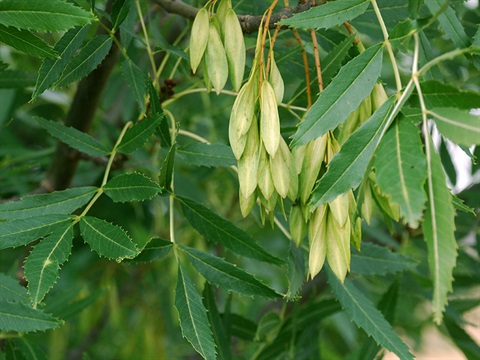Desert Ash

Fraxinus angustifolia
Origin: South-west Asia, Mediterranean
Size: 10m–20m H
Fruits: November to February
Flowers: August to October
Best removal time: August to October
What it does
Desert Ash was once a popular deciduous tree used commonly in streetscapes and gardens. It establishes in bushland and grasslands and also along stream banks and drainage lines. It out-competes native plants for moisture, light and nutrients and takes over these areas.
What it looks like
This deciduous tree is very dense with a rounded crown and can grow to around 20 metres in height. The bark is a grey-brown colour with prominent ridges. The leaves are opposite and around 14-20 cm long. Each leaf contains around 5-7 leaflets although sometimes can contain up to 13. The seeds form in large, drooping clusters and are flat, winged at the top and slightly twisted. Desert ash flowers are inconspicuous, green or purple in colour and appear in spring.
How it spreads
Desert Ash spreads by:
- seeds that are dispersed mainly by wind and water
- root suckers, can form dense stands when established this way
- readily available from nurseries and garden centres.
Removal
Remove by hand
With smaller plants and seedlings hand pulling is the best option, removing all roots. Be sure to cover up the disturbed area to reduce further weed recruitment.
Cut and paint
For trees that cannot be hand pulled or dug out, cut them off at ground level and paint the stump immediately with an undiluted glyphosate-based product.
Drill & fill
Drill several shallow holes (around 2-3cm deep) around the base of the trunk. Fill each hole immediately with an undiluted glyphosate-based product. The tree will then slowly die and may need to be removed later. This is useful when you do not want to open a hole in the canopy by removing a large tree.
Indigenous alternatives to plant
Many tree alternatives exist that are indigenous to the Yarra Ranges region and would make great substitutes for the Desert Ash. Some alternatives include:
Forest Lomatia, Lomatia fraseri
River Bottlebrush, Callistemon sieberi
How to dispose of weeds
By disposing of environmental weeds correctly you can prevent re-infestation on your property and elsewhere.
- Landfill (Weed Wipeout Tip vouchers available for some species).
- Green waste bins ensure that weeds are not able to spread.
- Woody weed stems can be bundled for green collection twice per annum.
- Composting (excluding seed heads or species with vegetative reproduction, e.g. Wandering Trad).
- Burning in accordance with Council and the Country Fire Authority (CFA) prescribed burning periods and regulations.
- Recovery and transfer stations available for weed tipping are Healesville, Wesburn, Coldstream, Lysterfield and Montrose.
Using chemicals
Non-chemical treatment is often the most effective and safe option especially on smaller scale infestations.
Where chemical use is undertaken:
- Always follow the manufacturer’s guidelines when using chemicals.
- Wear protective clothing and eyewear.
- When purchasing your herbicide, always ask for a Materials Safety Data Sheet (MSDS) or refer to the manufacturer’s website for specific safety guidelines and information.
- Some herbicides will kill other plants and not just the target species.
- When used near waterways herbicides can be very poisonous to aquatic life.
- Use chemicals sparingly and be sure that you are using the right chemical and application technique.
- Ensure the weather conditions are suitable (e.g. minimal wind and no rain expected).
- Apply herbicides at the correct time during the plant’s growth cycle so you get the best results.